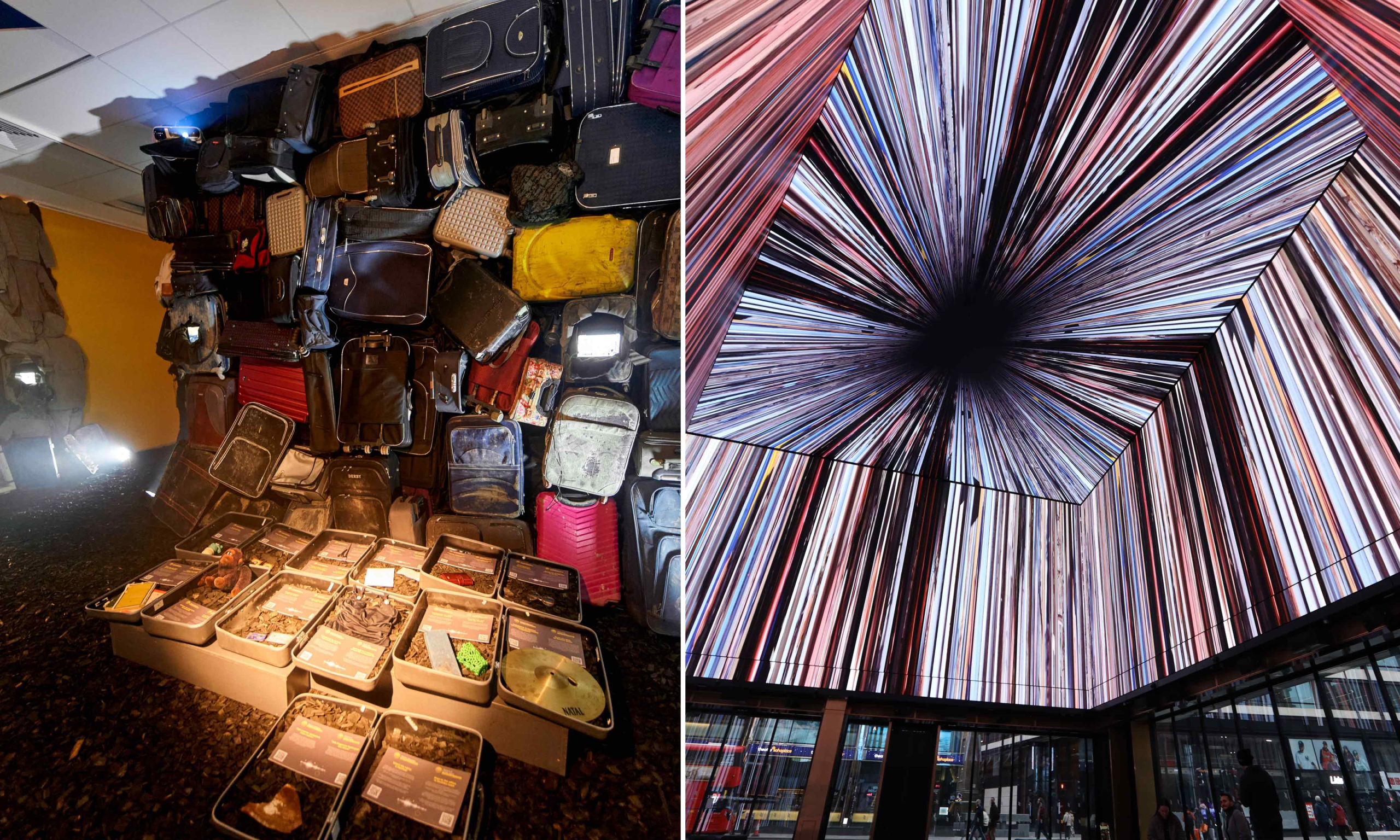Museum of Civilian Voices in Kyiv is a repository of 100,000 stories relating to the war, including Column of the ruined lives (left). Vlada (right) is an 11-hour sequence of videos from Telegram channels in Ukraine, collected by the artists Nick Crowe and Ian Rawlinson, which will play at Outernet, central London, on 24 February Kyiv: Kyrylo Avramenko. London: Outernet London
The people of Ukraine will be heard and seen as never before this weekend in events to mark the second anniversary of the Russian invasion.
Launched in Kyiv on 22 February, the Museum of Civilian Voices is a repository of 100,000 stories told by men, women and children living in the warzone. Meanwhile this Saturday 24th—the anniversary itself—members of the public in London will be able to see a “continuous artwork” based on thousands of clips and photographs uploaded from mobile phones in Ukraine, running in a dizzying 11-hour montage at the immersive institution Outernet.
Curators at the Kyiv museum promise an immersive, multi-media space which will “plunge” visitors into the lives and experiences of the Ukrainian people. It covers events since 2014, when a revolution overthrew the then Moscow-friendly regime, which in turn led to militants armed with Russian weapons annexing Crimea.
Visitors at the launch of the Museum of Civilian Voices, which organisers describe as a multi-media installation that “plunges” visitors into the experiences of their countrymen and women Kyrylo Avramenko
Organisers believe that exhibits relating to everyday aspects of Ukrainians’ lives, including their possessions and images of their pets, will help outsiders identify with the trauma they’re going through. Nastia Tykha became known around the world after a photograph of her and her 19 dogs went viral. “We have evacuated with our entire animal shelter,” she explains. A woman called Nadiya Svatko says, “My wardrobe and cockerel are signs that victory will be ours.” Her belongings, which somehow survived the flattening of her home, are seen as symbols of national resilience.
The backers of the exhibition, principally a foundation supported by a Ukrainian billionaire called Rinat Akhmetov, have an explicit goal of documenting alleged atrocities. They say the archive is “the basis for a fair condemnation of war crimes and a source of support for survivors who want to tell the truth.”
The artists Nick Crowe and Ian Rawlinson are bringing a marathon video event to Outernet, close to Tottenham Court Underground station in central London. The pair spent a year assembling Vlada, which means power in Ukrainian, from more than 27,000 videos which had been uploaded to the country’s Telegram channel. It will take over Outernet for the day, running from 1pm until midnight, with backing from a charity called ADOT which says it campaigns against “the epidemic of disconnect and conflict” in the world. Spectators will see hundreds of videos screened simultaneously to a driving soundtrack in what’s billed as a “deliberately overwhelming experience”.
A post shared by The Art Newspaper (@theartnewspaper.official)
Crowe and Rawlinson began collaborating on video spectaculars after they found themselves sharing a studio in Manchester 30 years ago. They say they trawled through hours of material for the new piece, which was premiered in Kyiv last October. “You’d imagine you could automate something like this but in reality, it requires a human eye to check that every element is sitting just as it should,” they said. “Vlada came about because like the rest of the world we were glued to our phones watching the horror unfold. It’s also our way of not letting that horror be forgotten, nor allowing it to overwhelm or paralyse us. After all, that’s what [Vladimir] Putin would like.”
While these shows may reveal more about the people who are resisting the Russians, Ukraine's pavilion at the Venice Biennale is all about concealment: it will be strung with netting like the camouflage used to deceive Putin’s troops.
Amid all the conceptual art on show in Venice, burnished in studios in preparation for the Biennale, the work at this pavilion could hardly be more homespun, with the nets inspired by the wartime tactic of weaving camouflage screens. The space is encased in Oleksandr Burlaka's architectural installation, composed of fabrics sourced from flea markets. The exhibition, Net Making, is curated by Viktoria Bavykina and Max Gorbatskyi. “Weaving nets is a key metaphor reflecting today's Ukraine,” they say. “Amid the Russian invasion, Ukrainians gather to weave camouflage nets. It is a bottom-up joint action that benefits each other and the country.”
The curator Marta Czyż with member of the Оpen Group collective (Yuriy Biley, Pavlo Kovach and Anton Varga), from Lviv, Ukraine. They will represent Poland at this year's Venice Biennale Photo: Piotr Czyż/Zachęta archive
Ukrainian art will also be on show in the Polish pavilion, with work from an artists’ collective from Lviv which represented Ukraine at the 2015 Biennale. Repeat after Me II has been called “a collective portrait of witnesses of the war in Ukraine” by Art Review. It replaces a controversial project by the Polish artist Ignacy Czwartos, which was rejected by the new coalition government in Warsaw. Critics have claimed that his work, said to examine the Polish experience in the clash between Soviet communism and German National Socialism, amounted to an “anti-European manifesto”, but Czwartos says he is a victim of censorship.

